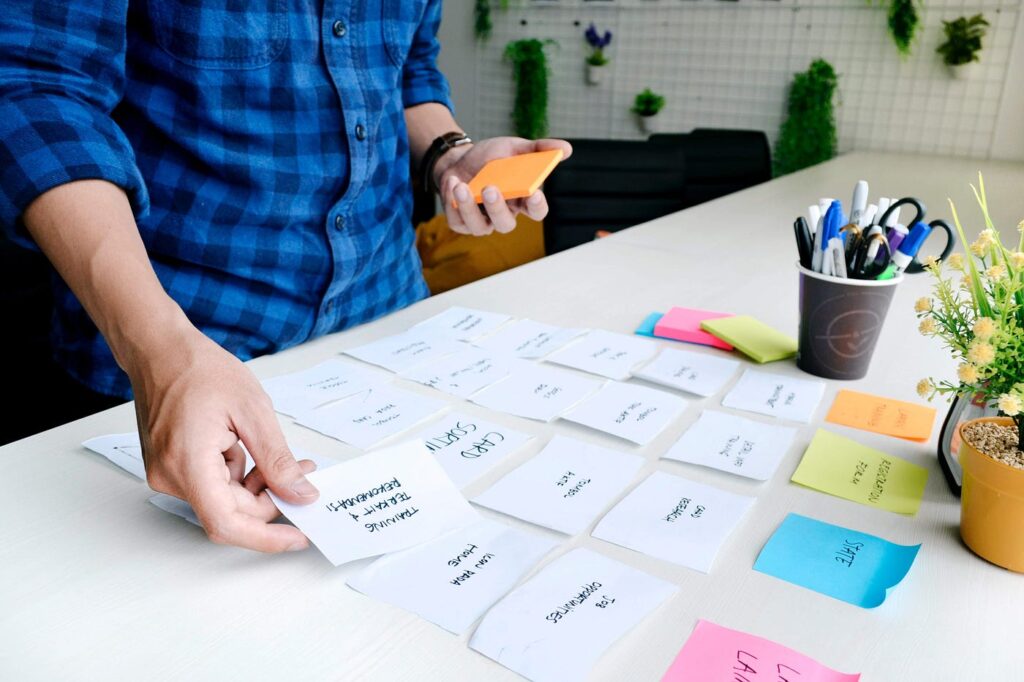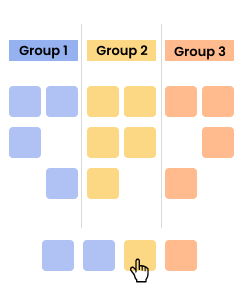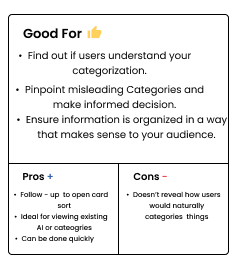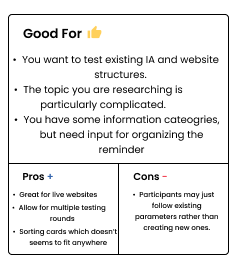
Introduction
In the realm of user experience (UX) design, understanding user behaviour and preferences is paramount. One of the key methods employed to gain such insights is card sorting. Card Sorting is a powerful UX research technique used to organize and structure information effectively. In this blog post, we’ll delve into the fundamentals of card sorting, its benefits, different types, best practices, and how it can be implemented to enhance the overall user experience.
What is card sorting?

Card sorting is a method to gather qualitative data about how users categorize and organize information. It involves presenting users with a set of label cards representing content or concepts and asking them to organize these cards into groups that make sense to them. By observing how users group and label the cards, designers gain valuable insights into users’ mental models, preferences, and expectations regarding information architecture.
Why is card sorting important?
Card sorting offers a wealth of benefits for UX designers and researchers.
- Uncover Mental Bodies: we all have mental models – an internal framework for understanding the world. card sorting helps you to see how users categorize information, regarding how they expect to find things on your website.
- Evaluate Existing AI: If you are redesigning a website, card sorting can expose any weaknesses in the current information architecture.
- Improve Navigation: By understanding how users group content, you can design a navigation system that aligns with their thought processes, leading to a more intuitive and user-friendly experience.
- Identify Labeling Issue: Card sorting can reveal if your content labels are unambiguous. users might group items that you wouldn’t expect highlighting the need for clearer labels.
Types of Card Sorting:
1. Open Card Sorting: In open card sorting, participants are given a set of unlabeled cards and asked to group them into categories of their creation. This method provides insight into users’ natural grouping tendencies and mental models.

2. Closed Card Sorting: In Closed card sorting, participants are provided with a predefined category labelled and asked to sort the card into three categories. This method is useful for validating existing information architectures or testing specific organizational structures.

3. Hybrid Card Sorting: Hybrid card sorting combines elements of both open and closed card sorting, allowing participants to create their categories while also providing predefined category labels. This method offers flexibility while still providing structure.

Best Practices for Conducting Card Sorting:
1. Define Clear Objectives: Clearly define the goals and objectives of the card-sorting exercise to ensure that they align with the project’s needs and objectives.
2. Recruit Representative Participants: Select Participants who represent the target user demographics to ensure that the insights gathered are relevant and actionable.
3. Keep Instructions simple: Provide clear and concise instructions to participants to ensure that they understand the task and feel comfortable completing it.
4. Use Online Tools: Utilize online card sorting tools such as Optimalsort or Trello to conduct remote card sorting sessions efficiently.
5. Analyze and Iterate: Analyze the results of the card sorting exercise to identify the common pattern and insights. use this information to iterate on the information architecture and design solutions accordingly.
Implementing card sorting in UX Design:
1. Planning: Define the research objective, recruit participants, and prepare the materials for the card sorting exercise.
2. Conducting: Facilitate the card sorting session, either in person or remotely, ensuring that participants understand the task and feel comfortable providing feedback.
3. Analyzing: Analyze the results of the card sorting exercise, and identify common themes, patterns, and insights.
4. Iterating: Use the insights gained from card sorting to inform iterative design improvements, refining the information architecture and content organization based on user feedback.
Tools for card sorting:
1. Physical cards and whiteboard: The Classic method, uses physical cards and a whiteboard for sorting.
2. Online Card Sorting Tools: Several online tools allow you to conduct card sorting sessions remotely. These tools offer features for managing participants, data analysis, and generating reports.
Conclusion:
Card sorting is a valuable UX research technique that can provide deep insights into users’ mental models, preferences, and expectations regarding information organization. By understanding how users categorize and structure information, designers can create more intuitive and user-friendly experiences. By incorporating card sorting into the UX design process, designers can validate design decisions, optimize information architectures, and ultimately enhance the overall user experience.